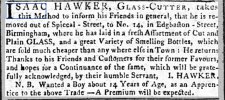I am working on a potted history of the Union Glassworks in Dartmouth Street. Not the full detail but a schedule of the key dates and the proprietors. It suits me to do this because it involves the Green family and I am already researching the Greens and their involvement at the Etna Glass Works, 42-44 Broad Street, Birmingham.
Here is my potted history of the Union Glass Works, Dartmouth Street, Birmingham. All of the characters referenced are documented in the free genealogy website www. familysearch.org.
Union Glassworks, 3-4 Dartmouth Street, Birmingham
1818 Established as Bacchus, Green & Green (Wrightson’s 1818 Directory), Of the Greens involved one is unquestionably George Joseph Green (1791-1871), the other could be either George Joseph Green’s father, James Green (1759-1823), or less likely it could be George Joseph Green’s half-brother James Green (1801-1847). George Joseph Green had been a partner from 1812 to 1817 in the glass manufacturing firm of Parkes, Grainger and Green at Holly Hall Glassworks, Dudley. The Bacchus members were George Bacchus (1777-1840) and two of his sons, John Ogden Bacchus J.P. (1806–1874) and William Bacchus (1811-1857).
1822 Trading as Bacchus and Green.
14 Aug 1830 The Monmouthshire Merlin reports that Bacchus, Green and Bacchus, Ashted glass-works received a royal visit from the Duchess of Kent and the Princess Victoria. Mr Bacchus jun attended their royal highnesses and had the honour of presenting to the Duchess of Kent a very handsome two-handled goblet, which she had seen manufactured.
1833 trading as George Bacchus & Co.
12 Mar 1838 Aris’s Birmingham Gazette published the minutes of the board meeting of the Birmingham Plate and Crown Glass Company. This was a business formed 6 April 1836 by George Joseph Green and George Bacchus to manufacture plate glass at a new works on the line of the old Birmingham canal at Smethwick. It had capital of £200,000 and was very successful. They advertised a tender on 22 Aug 1836 for the erection of a glasshouse, “with the cones”.
6 Apr 1840 Aris’s Birmingham Gazette contains two adjacent notices of dissolution of partnership concerning George Joseph Green. The first concerns “Manufacturers of Iron Goods, carrying on trade under the firm of George Joseph Green and Company”. The second adjacent article concerns, “dissolution of partnership between George Bacchus, George Joseph Green, John Ogdin Baccus, and William Bacchus, of Birmingham . . ., and of Tokenhouse Yard, London, Glass-makers, carrying on business under the firm of “Bacchus and Green” was and stands dissolved from this day so far as respects the said George Joseph Green. Dated 3rd day of April 1840”. So George Joseph Green was now out of the firm of Bacchus and Green and ceased his involvement with the Union Glass Works. Dartmouth Street, Birmingham.
13 Sep 1850 George Bacchus died, aged 64, shortly after attending divine service. One of several obituaries reports him as “one of the most excellent and deservedly esteemed inhabitants of Birmingham.
1841 George Bacchus & Sons (1841 Pigot’s Directory)
3 May 1851 Birmingham Journal reports that George Bacchus and sons exhibited a wide range of products at the Great Exhibition.
1855 George Bacchus & Sons (1855 White’s Directory)
6 Jan 1857 William Baccchus died, aged 45 at Westbourne Road, Edgbaston. This left John Ogden Bacchus as the only surviving member of the original partnership – but not for long.
7 May 1860 Messrs George Bacchus & Sons advertised in Aris’s Birmingham Gazette the sale of their entire stock at the Union Glass Works, Dartmouth Street “previous to the business being transferred to their successors”.
1860 John Ogden Bacchus sold out to the partnership of Stone, Fawdry & Stone. The partners were Benjamin Stone (1803–1882) and his son from his second marriage, Sir John Benjamin Stone M.P. (1838-1914) and Frederick Fawdry (1828-1867). Frederick married Catherine Stone (1832- 1857). She was the oldest daughter of Benjamin Stone from his first marriage. Sir John Benjamin Stone M.P. is better known as a prolific photographer and politician. He was the first Mayor of the Borough of Sutton Coldfield and became an M.P. in 1895. As well as his income from the Glass Works he was a partner in Smith, Stone and Knight which had a large paper mill in Landor Street, Birmingham. His income from both allowed him to travel extensively and to involve himself with many intellectual challenges, including politics and photography on a huge scale.
21 June 1867 Frederick Fawdry “of the firm of Stone, Fawdry and Stone, Union Glass Works. Dartmouth Street, Birmingham” died at his home, The Poplars, Sheldon. (Birmingham Daily Gazette 21 Jun 1867)
1881 Stone, Fawdry and Stone (1881 Kelly’s Directory)
1882 Sir John Benjamin Stone was elected master of the court of the Worshipful Company of Glass Sellers.
25 Feb 1882 Benjamin Stone died, aged 79 at Sutton Street, Aston Manor.
12 Mar 1895 the Union Glass Works was advertised for sale.
1896 Stone, Fawdry and Stone (1896 Kelly’s Directory)
well heres hoping but i will add it to his notes now.. on the 51 census he has moved to heneage st and is down as a glass maker also on the 51 and 61 i have 2 young harrington rellies at ashted row aged 15 and 13 down as glass blowers/makers..later on i will have a proper good read of this thread







